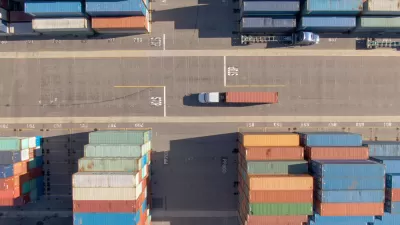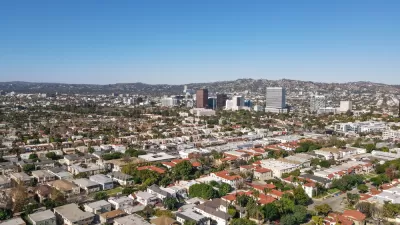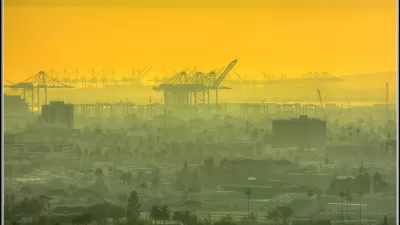Zoning has been blamed for a lot of things in recent years, but a global supply crunch increasing prices and creating shortages of household goods—and potentially ruining the holidays—is a new one.

In a story you might have missed from late October, local zoning laws in Southern California were suddenly shoved into the spotlight when the news broke that local zoning is at least partly responsible for the global supply crunch.
Now the world knows the Long Beach zoning code prevents the Port of Long Beach from stacking shipping containers more than two high. After the news went viral thanks to series of Tweets from Ryan Petersen, founder of the freight-forwarding tech company Flexport, Long Beach Mayor Robert Garcia moved quickly to temporarily suspend the limitations and allow containers to be stacked up to four high.
Multiple news channels picked up the news of the city of Long Beach's temporary zoning reforms, including:
- Supply chain crisis prompts city officials to suspend shipping container stacking limits (Long Beach Business Journal, October 22)
- Long Beach Eases Container Rules to Tackle ‘National Emergency’ (SupplyChainBrain, October 23)
- City of Long Beach allows logistics companies to stack containers higher (American Shipper, October 25)
- To Ease Storage Crisis, Long Beach Lifts Limits on Container Stacking (Maritime Executive, October 25)
- A tech CEO got big attention for his plan to ease the backlog at Los Angeles ports (NPR, November 3)
To be fair, the limitations created by the city of Long Beach's zoning code are only a part of the puzzle. Long Beach is one of two ports included in a massive port complex that also includes the Port of Los Angeles. Together, the two ports are credited as the source for about 40 percent of all shipping containers coming to the United States. According to an article by Donna Littlejohn, both ports have recently enacted a number of changes intended to speed up deliveries, such as allowing 24/7 operations and implementing a "hefty surcharge on ocean carriers for boxes that take up needed terminal dock space after a certain number of days."
Los Angeles has prepped new properties to hold overflow containers, but it hasn't, according to a new batch of Tweets sent by Petersen on November 10, relaxed its zoning restrictions on shipping container heights.
At least two commentaries suggest that California's infamous NIMBY culture and its preference for restrictive zoning regulations are to blame. An article for Bloomberg, written by Virginia Postrel, headlines its coverage of the ongoing episode with an implied criticism: "America's Supply Chain Collides With California's NIMBYism." Another article for the libertarian magazine Reason, written by Eric Boehm, piles on:
So there you have it. All it takes to get small, temporary relief from California's excessive zoning regulations is a national supply chain crisis that threatens to ruin Christmas.
The entire episode suggests that the realities of zoning codes are attracting new attention that could create the public sentiment and political will to shake the status quo. More high-profile criticism of California NIMBYism was published this week by The New York Times, with a video titled, "Blue States, You're the Problem" that faults zoning practices for the high costs of housing, displacement, and homelessness in the state.

Americans May Be Stuck — But Why?
Americans are moving a lot less than they once did, and that is a problem. While Yoni Applebaum, in his highly-publicized article Stuck, gets the reasons badly wrong, it's still important to ask: why are we moving so much less than before?

Using Old Oil and Gas Wells for Green Energy Storage
Penn State researchers have found that repurposing abandoned oil and gas wells for geothermal-assisted compressed-air energy storage can boost efficiency, reduce environmental risks, and support clean energy and job transitions.

Placekeeping: Setting a New Precedent for City Planners
How a preservation-based approach to redevelopment and urban design can prevent displacement and honor legacy communities.

San Francisco’s Muni Ridership Grew in 2024
The system saw its highest ridership since before the Covid-19 pandemic, but faces a severe budget shortage in the coming year.

Colorado Lawmakers Move to Protect BRT Funding
In the face of potential federal funding cuts, CDOT leaders reasserted their commitment to planned bus rapid transit projects.

Safe Streets Funding in Jeopardy
The Trump administration is specifically targeting bike infrastructure and other road safety projects in its funding cuts.
Urban Design for Planners 1: Software Tools
This six-course series explores essential urban design concepts using open source software and equips planners with the tools they need to participate fully in the urban design process.
Planning for Universal Design
Learn the tools for implementing Universal Design in planning regulations.
Heyer Gruel & Associates PA
City of Moreno Valley
Institute for Housing and Urban Development Studies (IHS)
City of Grandview
Harvard GSD Executive Education
Salt Lake City
NYU Wagner Graduate School of Public Service
City of Cambridge, Maryland






























